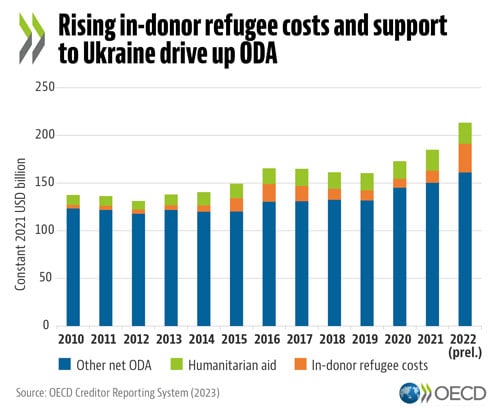12/04/2023 – Foreign aid from official donors in 2022 rose to an all-time high of USD 204 billion, up from USD 186 billion in 2021, as developed countries increased their spending on processing and hosting refugees and on aid to Ukraine, according to preliminary data collected by the OECD.
The 13.6% increase in real terms is one of the biggest ever increases in Official Development Assistance (ODA) provided by members of the OECD’s Development Assistance Committee (DAC) and the fourth consecutive year that ODA has set a new record high.
The increase was primarily due to a sharp rise in spending on processing and hosting refugees within donor countries to USD 29.3 billion, or 14.4% of ODA, up from USD 12.8 billion in 2021. Excluding these “in-donor” refugee costs, 2022 ODA still rose by 4.6% over 2021 in real terms.
 Another factor behind the 2022 increase was a jump in aid to Ukraine following Russia’s invasion and ongoing war of aggression. ODA to Ukraine in 2022 totalled USD 16.1 billion – up from just USD 918 million in 2021 – including USD 1.8 billion of humanitarian aid.
Another factor behind the 2022 increase was a jump in aid to Ukraine following Russia’s invasion and ongoing war of aggression. ODA to Ukraine in 2022 totalled USD 16.1 billion – up from just USD 918 million in 2021 – including USD 1.8 billion of humanitarian aid.
While in 2022 we saw a 0.7% decline in bilateral ODA to Least Developed Countries (LDCs) compared to the previous year, it is important to note that ODA to LDCs in 2022 was up by 9% in real terms compared to 2019 – the last year before the COVID pandemic.
“The COVID-19 pandemic and Russia’s war of aggression against Ukraine have aggravated global instability, hunger and extreme poverty, undoing decades of development progress in developing countries, particularly among the poorest and most vulnerable,” OECD Secretary-General Mathias Cormann said. “Unsurprisingly, significant additional resources were deployed by donor countries in support of refugees fleeing the war in Ukraine and in aid for Ukraine. Importantly, donor countries have provided ODA at an all-time high for the fourth year in a row. As well as providing support to deal with short-term pressures, we must continue to remain focused and accelerate progress in pursuit of our long-term development goals, particularly in support of the world’s poorest and most vulnerable countries.”
The 2022 ODA total is equivalent to 0.36% of DAC donors’ combined gross national income (GNI). While this ratio is still below the UN target of 0.7% ODA to GNI, it is the highest ratio recorded by the DAC in 40 years, increasing from 0.33% in 2021.
Five DAC members – Denmark, Germany, Luxembourg, Norway and Sweden – met or exceeded the 0.7% target in 2022.
ODA rose in 26 DAC countries in 2022, in many cases due to increased support for in-donor refugee costs, and fell in four countries. The largest increases were delivered by Poland (+255.6%), the Czech Republic (+167.1%), Ireland (+125.1%), Lithuania (+121.6%), Slovenia (+48.7%), and Austria (+36.2%).
“In a situation with increasing pressures on scarce development resources, we need to keep our commitment to support the least developed countries, many of which are in Africa,” OECD DAC Chair Carsten Staur said. “Russia’s aggression against Ukraine has resulted in a significant increase in funding for receiving refugees in donor countries. Some donors provided all or some of these extraordinary expenditures in addition to their already planned development programs in 2022, which is commendable.”
Within total ODA, humanitarian aid amounted to USD 22.3 billion, up by 1% in real terms compared to 2021. DAC donors spent USD 11.2 billion on COVID-19 related activities in 2022, down 45% from 2021. Vaccine donations amounted to USD 1.53 billion, a fall of 74.1% in real terms compared to 2021. Debt relief grants counted as ODA were very low at USD 60 million.
The share of loans and equity investments in gross bilateral ODA from DAC countries decreased to 18% in 2022 from 19% in 2021, with the rest provided as grants. Bilateral sovereign loans by DAC countries increased by 36%, on a grant-equivalent basis, from 2021. The countries with the highest share of loans in their bilateral ODA were Japan (60%), Korea (32%) and France (22%).
ODA makes up over two thirds of external finance for least-developed countries. The OECD also monitors flows from some non-DAC providers and private foundations. Preliminary data released by the OECD each April is followed by final statistics published around the end of the year with a detailed geographic and sectoral breakdown. (See the 2021 ODA breakdown under Development at .)
Net ODA has risen for the most part steadily in volume terms from just below USD 40 billion (in 2021 prices) in 1960, the first year ODA was measured. It has grown by 160% in real terms since 2000, when the Millennium Development Goals were agreed, despite the impact of crises such as the 2008 financial crisis and COVID-19 pandemic on provider economies. Net ODA has risen by 41% since the Sustainable Development Goals were adopted in 2015.
Links to aid data and background information:
- in detail
- Interactive charts showing








